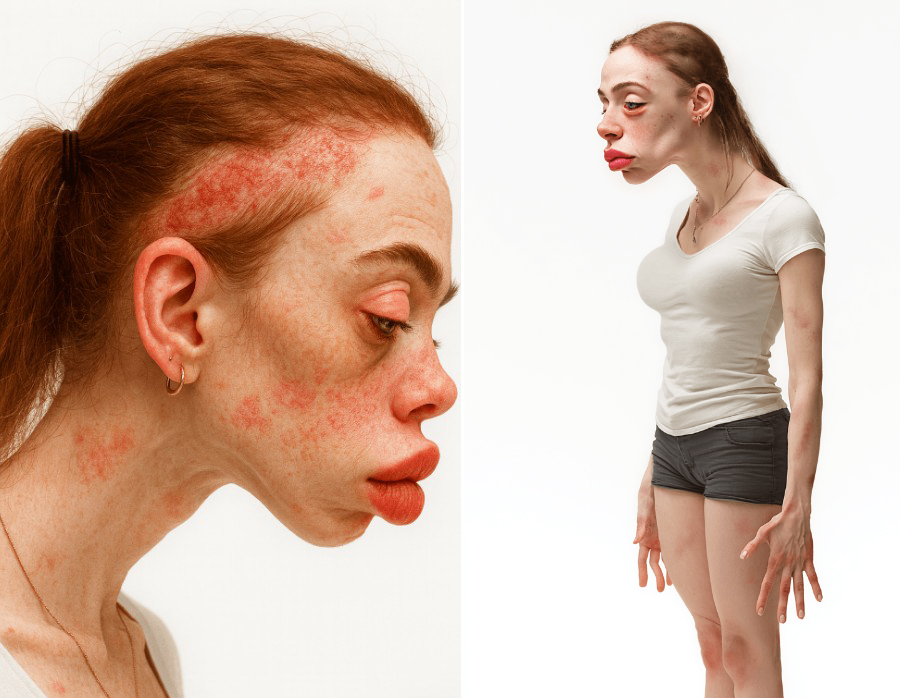According to The Economist, there are an estimated 30 to 50 million influencers worldwide, and this number is rapidly growing. These individuals are known for their polished, glamorous appearance. However, the faces of these social media stars may change significantly, and not for the better, according to experts from Casino.org.
Based on medical research and health data, the team of experts created Ava, a model of a typical influencer in 2050. Ava's appearance has deteriorated, with a hunched back, red eyes, poor skin, and thinning hair due to habits like chasing algorithms, an obsession with beauty standards, and relentless content creation. While representing the face of the future social media star, Ava serves as a warning for the present.
"She is a testament to the consequences of years of chasing algorithms, an obsession with beauty standards, and the 24/7 content creation machine," the experts said.
 |
A simulated image of an influencer in 2050. Photo: Casino.org |
A simulated image of an influencer in 2050. Photo: Casino.org
The hunched posture stems from the "text neck syndrome" caused by constantly looking down at phones, according to a 2023 BBC report. Many influencers can work up to 90 hours a week, with most of that time spent hunched over their smartphones. This posture causes rounded shoulders and a forward-tilted head, which can become a permanent deformity and cause chronic neck pain. A study in the journal Interdisciplinary Neurosurgery indicates that frequent phone users have a cervical spine "bent at an angle of 15 to 60 degrees".
Influencers often wear heavy makeup for extended periods, coupled with constant exposure to blue light from device screens and LED lights (like those used for livestreaming). This accelerates the aging process, causing wrinkles, inflammation, and premature aging. Experts call this phenomenon "digital aging," resulting in pigmentation changes, wrinkles, and persistent inflammation, as seen in Ava.
Dark circles under the eyes are a manifestation of computer vision syndrome, a consequence of influencers spending hours editing videos, livestreaming, and constantly working with screens. This leads to red, dry, blurry eyes, dark circles, and puffiness.
With irregular work hours and the habit of using screens late at night, Ava's natural sleep cycle is completely disrupted. "Over time, this can lead to chronic fatigue, hair thinning due to affected melatonin production, and swelling of the lower eyelids," experts warn.
The pursuit of the trend of injecting fillers into the face and lips can also distort natural facial proportions. This can be due to choosing the wrong type of filler, injecting it in the wrong place, or overusing it to lift facial features. The result is swollen cheeks, a pointed chin, and unnatural-looking skin.
Years of heavy hair extensions and tight hairstyles to maintain a camera-ready look can weaken hair follicles. This pressure on the scalp can cause patchy baldness, a receding hairline, and noticeable thinning hair that is difficult to restore.
In reality, the New Career Development Report of streamers, published in early 2025 by the China Online Association in collaboration with short video platforms, shows that over 60% of professional streamers broadcast more than 4 days a week. Of those, 57.4% stream daily for over 6 hours a day, exceeding recommended health standards.
Moreover, to attract attention and increase views, some streamers engage in unhealthy or dangerous broadcasting activities, such as excessive eating or extreme sports. Due to increasing market competition, some streamers face sales pressure, forcing them to work intensely, leading to exhaustion, sleep deprivation, and chronic illnesses.
"These problems not only affect their careers but also cause significant trouble for their personal lives," the report stated.
Binh Minh (Newweek, NY Post)












